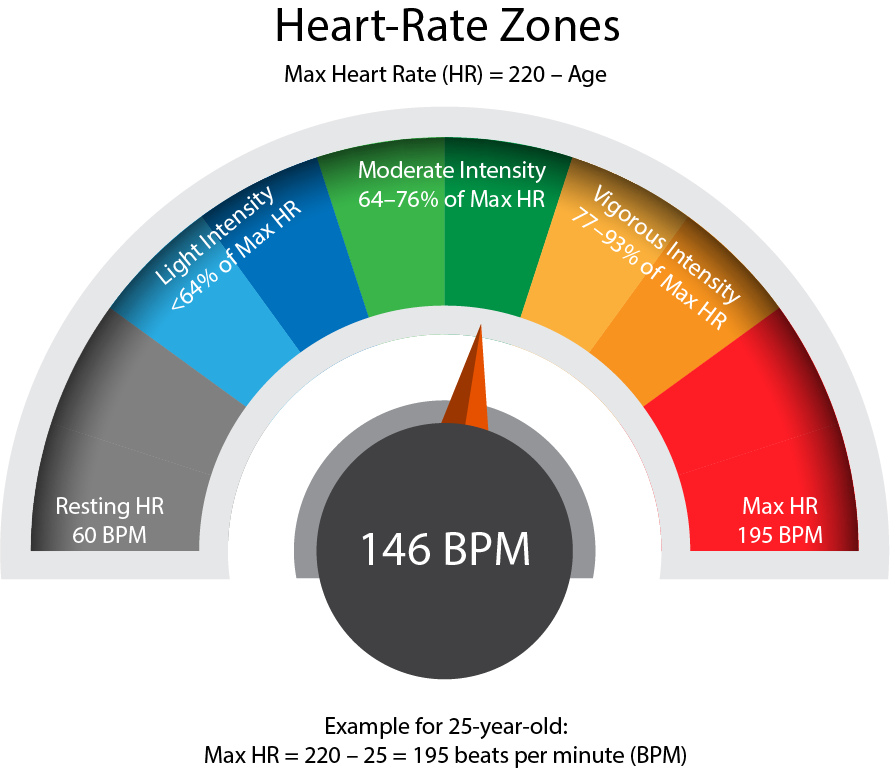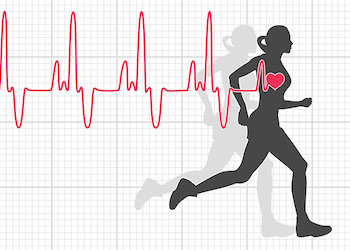Most smartwatches and fitness trackers keep track of your heart rate and count your activity when you’re working in a specific “heart-rate zone.” But what does that mean, and how are the zones determined? That answer ties back to the recommendation that Americans aim to perform 150 minutes of moderate-intensity physical activity (PA) every week.
Activity intensity
The Physical Activity guidelines define “moderate-intensity” PA as being 3.0–5.99 Metabolic Equivalents of Tasks (MET), and “vigorous-intensity” as at least 6.0 METs. For reference, 1 MET is the amount of energy you burn sitting in a chair (resting). Some exercise machines can calculate METs, but that doesn’t help you if you’re out on a track or using anything less than a high-end machine.
Intensity levels can be roughly translated to a percentage of your maximum heart rate (max HR), which you can easily calculate by subtracting your age from 220. The exact percentages can vary based on the source you look up, but the Centers for Disease Control and Prevention (CDC) lists moderate-intensity as 64–76% of your max HR, and vigorous-intensity as 77–93% of your max HR. For example, for a 25-year-old (max HR = 220 – 25 = 195) to perform moderate-intensity activity, their HR should be between 125–148 beats per minute (BPM). If you work or exercise within the ranges, you can estimate that you’re working at a moderate- or vigorous-intensity level.
Max HR = 220 – Age
Heart-rate zones
Smartwatches and activity trackers that use “heart-rate zones” to track intensity usually follow ranges that are close to CDC’s defined intensity levels. If your tracker uses a 5-zone range, zones 2–3 are usually in the moderate-intensity window, and zone 4 usually corresponds to vigorous intensity. Check your device’s settings to see how it defines each zone, and you can usually edit the ranges if you don’t like how it matches up with the guidelines.
Tracking your heart rate zone while you exercise is an easy way to make sure you’re working hard enough to see the physical benefits. Rather than remembering “I need to be between 125–148 BPM” every time you look at your HR monitor, you can just look to see “am I in zone 3” and either work harder or scale it back as necessary.

The fat-burning zone
The “fat-burning zone” is the idea that you need to maintain your HR in a specific zone where your body uses the greatest amount of fat for energy. While there’s some truth to the “fat-burning zone,” the way it works is often misrepresented. At about 70% of your max heart rate, your body burns fat at the highest rate. This means you burn the most grams of fat per minute. However, the fat-burning process takes at least 20 minutes to ramp up your body’s energy production.
Your body uses 2 main macronutrients for energy: carbohydrates and fats. At any given time, your body uses both for energy, but the proportion of fat to carbs varies. The intensity and duration of your workout are important for the fat-to-carbs ratio. Your body starts to burn fat for energy after 20–30 minutes of lower-intensity workouts. During the shorter-duration, high-intensity exercise, your body prioritizes burning carbs because they’re a “faster-acting” source of energy. However, this doesn’t mean you burn more fat with low-intensity exercise than high-intensity exercise. If you exercise for 30 minutes at low intensity one day, and 30 minutes at high intensity the next day, you’ll actually burn more fat calories on the high-intensity day because you burn a greater total number of calories.
How do you “burn more fat”? The short answer is: exercise more. There’s no single best way to burn fat, so you can find a combination of ways that works best for you. If you prefer the more long-slow-distance-type training, that will work well because your body uses more fat for energy for a longer duration.
If you prefer shorter, high-intensity workouts a few times a week, you can burn more calories in a short period of time. Resistance training to build muscle will help burn fat. Even though you mostly use carbs for energy during resistance training, building muscle will increase your resting metabolic rate. After your workout, you’ll continue to burn calories at a higher rate while you recover. Muscles are hungry, so you’ll burn more calories just by doing your normal day-to-day activities.





